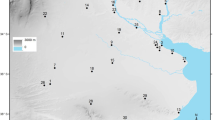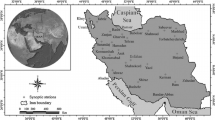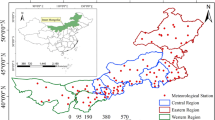Abstract
In this study, the impacts of both temperature and wind speed trends on reference evapotranspiration have been assessed using as a case study the Southern Italy, which present a wide variety of combination of such climatic variables trends in terms of direction and magnitude. The existence of statistically significant trends in wind speed and temperature from observational datasets, measured in ten stations over Southern Italy during the period 1968–2004, has been investigated. Time series have been examined using the Mann–Kendall nonparametric statistical test in order to detect possible evidences of wind speed and temperature trends at different temporal resolution and significance level. Once trends have been examined and quantified, the effects of these trends on seasonal reference evapotranspiration have been evaluated using the FAO-56 Penman–Monteith equation. Results quantified the effects of extrapolated temperature and wind speed trends on reference evapotranspiration. Where these climatic drivers are on the same direction, reference evapotranspiration generally increases during the growing season due to a nonlinear overlapping of effects. Whereas wind speed decreases and temperature increases, there is a sort of counterbalancing effect between the two considered climatic forcing in determining future reference evapotranspiration.







Similar content being viewed by others
References
Aeronautica Militare (2009) Atlante Climatico d'Italia. Tiferno Grafica s.r.l. Città di Castello (Perugia), Pratica di Mare
Allen RG, Pereira LS, Raes D, Smith M (1998) Crop evapotranspiration-Guidelines for computing crop water requirements-FAO Irrigation and drainage paper 56 FAO. Rome 300:6541
Atkinson N, Harman K, Lynn M, Schwarz A, Tindal A (2006) Long-term wind speed trends in northwestern Europe Garrad Hassan, Bristol:4
Bakker A, Van den Hurk B, Coelingh J (2013) Decomposition of the windiness index in the Netherlands for the assessment of future long‐term wind supply. Wind Energy 16:927–938
Balling RC, Idso SB (1989) Historical temperature trends in the United-States and the effect of urban-population growth. J Geophys Res-Atmospheres 94:3359–3363
Blaney HF (1952) Determining water requirements in irrigated areas from climatological and irrigation data
Brázdil R, Chromá K, Dobrovolný P, Tolasz R (2009) Climate fluctuations in the Czech Republic during the period 1961–2005. Int J Climatol 29:223–242
Brutsaert W, Parlange M (1998) Hydrologic cycle explains the evaporation paradox Nature 396:30–30
Chattopadhyay N, Hulme M (1997) Evaporation and potential evapotranspiration in India under conditions of recent and future climate change Agricultural and Forest Meteorology 87:55–73
Chavuenet W (1871) A manual of spherical and practical astronomy.
Chen L, Li D, Pryor S (2013) Wind speed trends over China: quantifying the magnitude and assessing causality. Int J Climatol 33:2579–2590
Cohen S, Ianetz A, Stanhill G (2002) Evaporative climate changes at Bet Dagan, Israel, 1964–1998. Agric For Meteorol 111:83–91
Collins DA, Della-Marta PM, Plummer N, Trewin BC (2000) Trends in annual frequencies of extreme temperature events in Australia. Aust Meteorol Mag 49:277–292
Cusack S (2013) A 101 year record of windstorms in the Netherlands. Clim Chang 116:693–704
Dale L, Milborrow D, Slark R, Strbac G (2004) Total cost estimates for large-scale wind scenarios in UK Energy Policy 32:1949–1956
Dinpashoh Y, Jhajharia D, Fakheri-Fard A, Singh VP, Kahya E (2011) Trends in reference crop evapotranspiration over Iran. J Hydrol 399:422–433
Donohue RJ, McVicar TR, Roderick ML (2010) Assessing the ability of potential evaporation formulations to capture the dynamics in evaporative demand within a changing climate. J Hydrol 386(1):186–197
Drake BG, Gonzàlez-Meler MA, Long SP (1997) More efficient plants: a consequence of rising atmospheric CO2?. Annual review of plant biology 48(1):609–639
Eamus D (1991) The interaction of rising CO and temperatures with water use efficiency. Plant, Cell & Environment 14(8):843–852
Earl N, Dorling S, Hewston R, von Glasow R (2013) 1980–2010 Variability in UK Surface Wind Climate Journal of Climate 26
Elnesr M, Alazba A (2013) Effect of climate change on spatio-temporal variability and trends of evapotranspiration, and its impact on water resources management in the Kingdom of Saudi Arabia Climate change—realities, impacts over ice cap, sea level and risks. In Tech 10:54832
Fu, G., Charles, S.P., Yu, J. (2009). A critical overview of pan evaporation trends over the last 50 years. Climatic Change, 97(1–2), 193–214.
Golubev VS et al. (2001) Evaporation changes over the contiguous United States and the former USSR: a reassessment Geophysical Research Letters 28:2665–2668
Guitjens JC (1982) Models of alfalfa yield and evapotranspiration Journal of the irrigation and drainage division 108:212–222
Guoyu R et al (2005) Climate changes of China’s mainland over the past half century. Acta Meteorologica Sinica 63:942–956
Hamon WR (1963) Computation of direct runoff amounts from storm rainfall Int Assoc Sci Hydrol Publ 63:52–62
Harbeck GE (1962) A practical field technique for measuring reservoir evaporation utilizing mass-transfer theory. Office, US Government Printing
Hargreaves GH, Samani ZA (1985) Reference crop evapotranspiration from ambient air temperature American Society of Agricultural Engineers (Microfiche collection)(USA) no fiche no 85–2517
Hazlett M (2011) Climate change could have major impacts on wind resources North American Windpower Zackin 3
Hewston R, Dorling SR (2011) An analysis of observed daily maximum wind gusts in the UK Journal of Wind Engineering and Industrial Aerodynamics 99:845–856
Hirsch RM, Slack JR, Smith RA (1982) Techniques of trend analysis for monthly water quality data Water Resources Research 319:83–95
Holt E, Wang J (2012) Trends in wind speed at wind turbine height of 80 m over the contiguous United States using the North American Regional Reanalysis (NARR) Journal of Applied Meteorology & Climatology 51
Irmak S, Kabenge I, Skaggs KE, Mutiibwa D (2012) Trend and magnitude of changes in climate variables and reference evapotranspiration over 116-yr period in the Platte River Basin, central Nebraska–USA. J Hydrol 420:228–244
Jhajharia D, Dinpashoh Y, Kahya E, Singh VP, Fakheri‐Fard A (2012) Trends in reference evapotranspiration in the humid region of northeast India Hydrological Processes 26:421–435
Jiang Y, Luo Y, Zhao Z, Tao S (2010) Changes in wind speed over China during 1956–2004 Theoretical and Applied Climatology 99:421–430
Jiménez-Muñoz JC, Sobrino JA, Mattar C (2012) Recent trends in solar exergy and net radiation at global scale. Ecol Model 228:59–65
Kendall MG (1962) Rank correlation methods. Hafner, New York
Klink K (1999) Trends in mean monthly maximum and minimum surface wind speeds in the coterminous United States, 1961 to 1990 Climate Research 13:193–205
Kothyari UC, Singh VP (1996) Rainfall and temperature trends in India Hydrological Processes 10:357–372
Kousari MR, Ahani H (2012) An investigation on reference crop evapotranspiration trend from 1975 to 2005 in Iran. Int J Climatol 32:2387–2402
Kruger AC, Shongwe S (2004) Temperature trends in South Africa: 1960–2003. Int J Climatol 24:1929–1945
Lawrimore JH, Peterson TC (2000) Pan evaporation trends in dry and humid regions of the United States Journal of Hydrometeorology 1
Lettenmaier DP, Wood EF, Wallis JR (1994) Hydro-climatological trends in the continental United-States, 1948–88 Journal of Climate 7:586–607
Lin C, Yang K, Qin J, Fu R (2013) Observed coherent trends of surface and upper-air wind speed over China since 1960 Journal of Climate 26
Liu X, Zhang D (2013) Trend analysis of reference evapotranspiration in Northwest China: the roles of changing wind speed and surface air temperature Hydrological Processes 27:3941–3948
Liu H, Li Y, Josef T, Zhang R, Huang G (2014) Quantitative estimation of climate change effects on potential evapotranspiration in Beijing during 1951–2010. J Geog Sci 24:93–112
Mann HB (1945) Non parametric tests again trend. Econometrica 13:245–259
Manton MJ (2001) Trends in extreme daily rainfall and temperature in Southeast Asia and the South Pacific: 1961–1998. Int J Climatol 21:269–284
McKenney MS, Rosenberg NJ (1993) Sensitivity of some potential evapotranspiration estimation methods to climate change. Agric For Meteorol 64(1):81–110
McVicar TR, Van Niel TG, Li LT, Roderick ML, Rayner DP, Ricciardulli L, Donohue RJ (2008) Wind speed climatology and trends for Australia, 1975–2006: Capturing the stilling phenomenon and comparison with near-surface reanalysis output Geophysical Research Letters 35 doi:10.1029/2008gl035627
McVicar TR et al (2012) Global review and synthesis of trends in observed terrestrial near-surface wind speeds: implications for evaporation. J Hydrol 416:182–205. doi:10.1016/j.jhydrol.2011.10.024
Monteith J (1965) Evaporation and environment. Symp Soc Exp Biol 19:205–234
Moratiel R, Snyder RL, Duran JM, Tarquis AM (2011) Trends in climatic variables and future reference evapotranspiration in Duero Valley (Spain) Natural Hazards and Earth System Sciences 11:1795–1805 doi:10.5194/nhess-11-1795-2011
Penman HL (1948) Natural evaporation from open water, bare soil and grass Proceedings of the Royal Society of London Series A Mathematical and Physical Sciences 193:120–145
Peterson T (1995) Evaporation losing its strength. Nature 377:687–688
Piervitali E, Colacino M, Conte M (1997) Signals of climatic change in the central-western Mediterranean basin Theoretical and Applied Climatology 58:211–219
Pirazzoli PA, Tomasin A (2003) Recent near-surface wind changes in the central Mediterranean and Adriatic areas. Int J Climatol 23:963–973
Priestley C, Taylor R (1972) On the assessment of surface heat flux and evaporation using large-scale parameters Monthly weather review 100:81–92
Pryor S, Ledolter J (2010) Addendum to “Wind speed trends over the contiguous United States” Journal of Geophysical Research: Atmospheres (1984–2012) 115
Pryor S, Barthelmie R, Kjellström E (2005) Potential climate change impact on wind energy resources in northern Europe: analyses using a regional climate model Climate Dynamics 25:815–835
Pryor SC et al. (2009) Wind speed trends over the contiguous United States Journal of Geophysical Research-Atmospheres 114 doi:10.1029/2008jd011416
Rahim M, Yoshino J, Doi Y, Yasuda T (2012) Effects of Global Warming on the Average Wind Speed Field in Central Japan Journal of Sustainable Energy & Environment 3:165–171
Rayner D (2007) Wind run changes: the dominant factor affecting pan evaporation trends in Australia Journal of Climate 20
Roderick ML, Farquhar GD (2002) The cause of decreased pan evaporation over the past 50 years Science 298:1410–1411
Roderick ML, Farquhar GD (2004) Changes in Australian pan evaporation from 1970 to 2002. Int J Climatol 24:1077–1090
Roderick ML, Rotstayn LD, Farquhar GD, Hobbins MT (2007) On the attribution of changing pan evaporation Geophysical Research Letters 34 doi:10.1029/2004JD004511
Sahsamanoglou HS, Makrogiannis TJ (1992) Temperature trends over the Mediterranean Region, 1950–88 Theoretical and Applied Climatology 45:183–192
Sailor DJ, Smith M, Hart M (2008) Climate change implications for wind power resources in the Northwest United States Renewable Energy 33:2393–2406
Schiesser H, Pfister C, Bader J (1997) Winter storms in Switzerland north of the Alps 1864/1865–1993/1994 Theoretical and Applied Climatology 58:1–19
Siegismund F, Schrum C (2001) Decadal changes in the wind forcing over the North Sea Climate Research 18:39–45
Smits A, Klein Tank A, Können G (2005) Trends in storminess over the Netherlands, 1962–2002. Int J Climatol 25:1331–1344
Stocker DQ (2013) Climate change 2013: The physical science basis Working Group I Contribution to the Fifth Assessment Report of the Intergovernmental Panel on Climate Change, Summary for Policymakers, IPCC
Talaee PH, Some’e BS, Ardakani SS (2013) Time trend and change point of reference evapotranspiration over Iran Theoretical and Applied Climatology:1–9
Thomas A (2000) Spatial and temporal characteristics of potential evapotranspiration trends over China. Int J Climatol 20:381–396
Thornthwaite CW (1948) An approach toward a rational classification of climate. Geogr Rev 38:55–94
Tokinaga H, Xie S-P (2011) Weakening of the equatorial Atlantic cold tongue over the past six decades Nature Geoscience 4:222–226
Tuller SE (2004) Measured wind speed trends on the west coast of Canada. Int J Climatol 24:1359–1374
Turc L (1961) Evaluation des besoins en eau d’irrigation, évapotranspiration potentielle Ann agron 12:13–49
Viola F, Liuzzo L, Noto LV, Lo Conti F, La Loggia G (2014) Spatial distribution of temperature trends in Sicily. Int J Climatol 34:1–17
Wan H, Wang XL, Swail VR (2010) Homogenization and trend analysis of Canadian near-surface wind speeds. J Clim 23:1209–1225. doi:10.1175/2009jcli3200.1
Ward MN, Hoskins BJ (1996) Near-surface wind over the global ocean 1949–1988. J Clim 9:1877–1895
Xu C-Y, Singh V (2002) Cross comparison of empirical equations for calculating potential evapotranspiration with data from Switzerland Water Resources Management 16:197–219
Xu M, Chang CP, Fu C, Qi Y, Robock A, Robinson D, Zhang Hm (2006) Steady decline of east Asian monsoon winds, 1969–2000: Evidence from direct ground measurements of wind speed Journal of Geophysical Research: Atmospheres (1984–2012) 111
Young I, Zieger S, Babanin A (2011) Global trends in wind speed and wave height Science 332:451–455
Zhai PM, Pan XH (2003) Trends in temperature extremes during 1951–1999 in China. Geophys Res Lett 30
Zhang L, Ren G (2003) Change in dust storm frequency and the climatic controls in northern China. Acta Meteorologica Sinica 61:744–750
Zhang XB, Vincent LA, Hogg WD, Niitsoo A (2000) Temperature and precipitation trends in Canada during the 20th century Atmos-Ocean 38:395–429
Zongxing L et al. (2014) Spatial and temporal trend of potential evapotranspiration and related driving forces in Southwestern China, during 1961–2009 Quaternary International
Zunya W, Yihui D, Jinhai H, Jun Y (2004) An updating analysis of the climate change in China in recent 50 years. Acta Meteorologica Sinica 62:228–236
Zuo D, Xu Z, Yang H, Liu X (2012) Spatiotemporal variations and abrupt changes of potential evapotranspiration and its sensitivity to key meteorological variables in the Wei River basin, China Hydrological Processes 26:1149–1160
Author information
Authors and Affiliations
Corresponding author
Rights and permissions
About this article
Cite this article
Liuzzo, L., Viola, F. & Noto, L.V. Wind speed and temperature trends impacts on reference evapotranspiration in Southern Italy. Theor Appl Climatol 123, 43–62 (2016). https://doi.org/10.1007/s00704-014-1342-5
Received:
Accepted:
Published:
Issue Date:
DOI: https://doi.org/10.1007/s00704-014-1342-5




